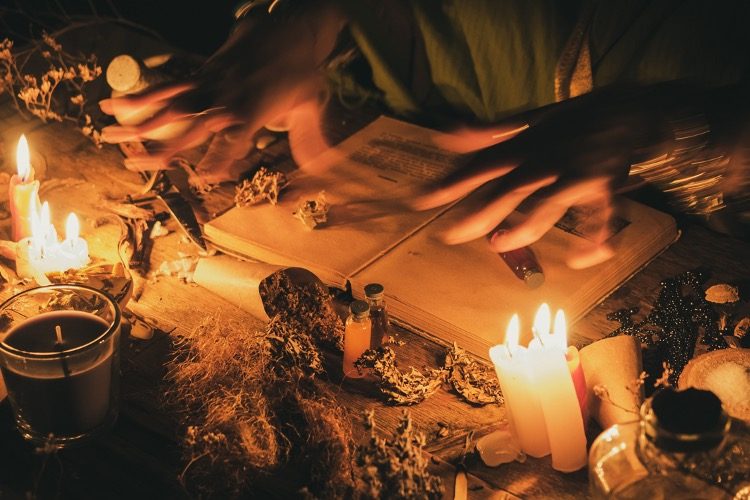
With the latest report from Axios, maybe open borders Republicans such as GOP presidential candidate Nikki Haley and former President George W. Bush can dispense with the claim that Hispanic immigrants are, down to a man, “natural conservatives” with “good family values” because so many are pew-warming Catholics.
Axios reports that American Hispanics are increasingly embracing the demonic; i.e. practicing witchcraft and returning to their “roots.”
News reports during the last few years confirm it, and at least one state, California, encouraged the satanic practice by approving public-school prayers to false Aztec gods.
But young “Latinos” aren’t the only demographic calling forth demons from the netherworld. So are the pasty-white worthies of the WEC in Davos. They actually invited a witch to cast spells.
“Latino” Witchcraft
Axios reported the story as if “Latinos,” by taking up the demonic practices once again, were harkening back to the way they made corn tortillas or tequila or weaved blankets in the old days.
But what the website described isn’t so innocent.
“Ancient brujería — or Latin American and Caribbean witchcraft — has seen a resurgence in recent years as some U.S. Latinos reclaim the once-taboo traditions to connect with their roots, exercise self-care and build community,” the website reported.
“Younger generations,” the report continued “increasingly embrace other parts of their heritage, speaking Spanish, using accent marks, or, in some cases, praying to folk saints.”
Except that Brujeria, which is witchcraft, again, is demonic, even if its mix of African and MesoAmerican rites were “fused with some Catholic traditions.”
Book publishers, of course, out to make a quick buck, capitalized on the new “Latino” thirst for witchcraft and “have released numerous books about it and an increasing number of social media accounts devoted to its practices have emerged.”
And, as expected, the Axios scribe hustled off to find the local entrepreneur who sells demonic wares:
Brujería “just opens up a lot of doorways to get back to our roots, feel more connected to them,” says Eric J. Labrado, who owns a witch shop in Austin, Texas, and has co-written two books on Mexican and Mexican American brujería.
“In my case, that’s helped me grow as a person and understand myself better,” he says.
The rituals can “help better ourselves by removing blockages, tackling grief and pain that maybe we even carried from our ancestors so we have the courage to move forward.”
An herbalist called Suhaly Bautista-Carolina, proprietress of the Moon Mother Apothecary website, called the practice a “blessing and a gift.”
Cue in the tarot card reader, Lorraine Monteagut, author of Brujas: The Magic and Power of Witches of Color:
“We’re in this mode of discovery of the many kinds of traditions and iterations of practices, and we are connecting and sharing with each other what used to be kept hush-hush or was maybe necessarily a secret,” she says.
And, she avers, “by rooting us, maybe we can teach our descendants to feel a little more safe in their bodies, with a little more belonging than what we felt as immigrants or kids of immigrants.”
The rush to embrace calling up demons is, apparently, prevalent among “Latino” members of Gen Z. They are “more vocal about the need for work-life balance and for openly discussing mental health.”
A significant number of Gen Zers are, indeed, mentally ill, but in any event, social media and leftist publications that target the young are likely reasons the practice is spreading. A search for “Brujeria” on X will return accounts about it, and Teen Vogue published a pro-Brujeria propaganda piece in 2019.
More recently, again, the World Economic Forum invited a witch to call forth demons in Davos. Why the organizers needed that help is unknown. WEC chief demon Klaus Schwab was already there.
California Installed Aztec Prayers
One must hope that the “Latino” embrace of Brujeria is one of those bogus trend stories, but alas, normalizing the demonic isn’t just a private-sector enterprise.
Just last year, California settled a lawsuit brought by parents after the state approved its Ethnic Studies Model Curriculum that included ritual chants to five Aztec gods.
“The curriculum recommends that teachers lead their students in a series of indigenous songs, chants, and affirmations, including the “In Lak Ech Affirmation,” which appeals directly to the Aztec gods,” City Journal’s Christopher Rufo reported:
Students first clap and chant to the god Tezkatlipoka — whom the Aztecs traditionally worshiped with human sacrifice and cannibalism — asking him for the power to be “warriors” for “social justice.” Next, the students chant to the gods Quetzalcoatl, Huitzilopochtli, and Xipe Totek, seeking “healing epistemologies” and “a revolutionary spirit.” Huitzilopochtli, in particular, is the Aztec deity of war and inspired hundreds of thousands of human sacrifices during Aztec rule. Finally, the chant comes to a climax with a request for “liberation, transformation, [and] decolonization,” after which students shout “Panche beh! Panche beh!” in pursuit of ultimate “critical consciousness.”
The chants have a clear implication: the displacement of the Christian god, which is said to be an extension of white supremacist oppression, and the restoration of the indigenous gods to their rightful place in the social justice cosmology. It is, in a philosophical sense, a revenge of the gods.
What most young “Latinos” probably don’t know is the role that human sacrifice played in these ancient demonic rites, not least the sacrifice of children. To appease Huitzilopochtli, the Sun god, the victim was placed on a stone table atop Templo Mayor in Tenochtitlan, and “priests” cut open the victim’s abdomen with an obsidian knife and removed his beating heart.
Aztecs appeased the Rain god Tlaloc with the blood — and tears — of children before they were burned alive. The more the children cried in agony, the Aztecs believed, the more rain Tlaloc sent.


